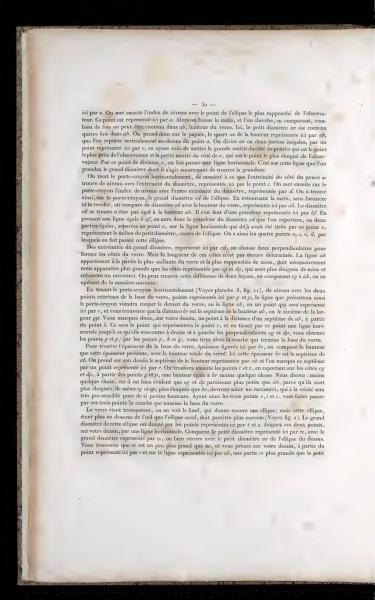Page 30
Here by e. We then place the level index with the point of the ellipse closest to the observer. This point is represented here by a. Then we lower the hand and try, by comparison, how many times ae can be contained within ab, the height of the glass. Here, the small diameter ae is contained four times in ab. Therefore, we take on paper, the quarter of the height represented here by ab, which is then placed vertically above the point a. We divide ae into two unequal parts, by a point represented here by o, making sure to put the larger half towards the point a, which is nearest to the observer, and the smaller half towards e, the furthest from the observer. Through this point of division o, a horizontal line is drawn. It is on this line that we will take the large diameter whose size we now want to find.
We hold the pencil holder horizontally so that the tip on the thumb side is level with the end of the diameter represented here by the point a. Then, place on the pencil holder the level index with the other end of the diameter, represented by e. Thus, on the pencil holder, we have the large diameter cd of the ellipse. By turning the hand, without advancing or retreating it, we compare this diameter with the height of the glass, represented here by ab. The diameter cd is not equal to the height ab. A size equal to éy is missing. By drawing a line equal to éy, we thus get the size of the diameter cd which will be placed in two equal parts, separated by the point o, on the horizontal line which was already drawn by this point o, and passing through the middle of the small diameter, the center of the ellipse. We thus have the four points a, e, y, through which this ellipse passes.
The ends of the large diameter, represented here by cd, lower two perpendiculars to form the sides of the glass. But the length of these sides is not yet determined. The line rs, belonging to the most protruding part of the glass and closest to us, must necessarily appear larger than the sides represented by eg and dp, which are further away from us and thus foreshortened. This difference can be found in two ways, by comparing ae to ab, or by proceeding in the following way:
By holding the pencil holder horizontally (see plate 3, fig. 11), level with the two extreme points of the base of the glass, points represented here by and ep, the line thus presented by the pencil holder will intersect the front of the glass in, line ab, at a point which is represented here by r, and you will find that the distance from r is one-seventh of the height ab, or one-sixth of the width gp. Thus, you mark on your drawing, a point at a distance of one-seventh of ab, from point a. This will be the point representing point r, and by drawing a horizontal line through this point until it meets on the right the line cs perpendiculars eg and dp, you obtain points t and p; through points p, t, and st, you then draw the curve that ends the base of the glass.
To find the thickness of the base of the glass, compare the height that this thickness presents, with the total height of the glass: here this thickness br is one-seventh of ab. On your drawing, take the seventh of the height represented by ab and mark this seventh by a point represented here by r. Then find points t and z by laying out on the sides eg and dp, from points g and p, a height equal to br minus something. We say: minus something, because it is obvious that eg and dp appear smaller than ab, because they are further away, same with egp, further than dr, should undergo a slight foreshortening, which will be very subtle for such small heights. Having thus the three points r, t, and z, you pass through these points the curve that ends the base of the glass.
The glass being transparent, one can see the bottom, which forms another ellipse; but this ellipse, being more under the eye than the ellipse aced, should appear more open (See fig. 2). The large diameter of this ellipse is given by the points represented here by t and z. Connect these two points on your drawing with a horizontal line. Compare the small diameter represented here by rz with the large diameter represented by tz, or else with the small diameter ae of the ellipse above. You will find that rs is a bit larger than ae, and you take on your drawing, from the point represented here by r and on the line represented here by ab, a part rs larger than the small
This passage discusses the detailed process of drawing an ellipse and its components by creating comparative measurements. The instructions guide the reader on using a pencil holder to measure diameters and angles, ensuring precise measurements through a method of divisions and foreshortening. Additionally, it describes the need for adjustments in drawing the base of a transparent glass to achieve accurate dimensional appearances.
